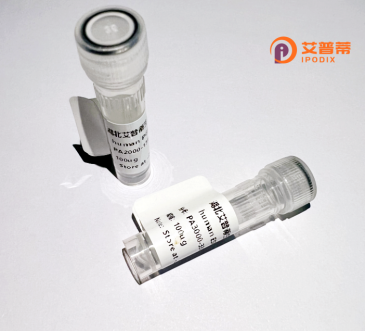
| 纯度 | >90%SDS-PAGE. |
| 种属 | Human |
| 靶点 | ZNF434 |
| Uniprot No | Q9NX65 |
| 内毒素 | < 0.01EU/μg |
| 表达宿主 | E.coli |
| 表达区间 | 1-697 aa |
| 活性数据 | MMAAVKSTEA HPSSNKDPTQ GQKSALQGNS PDSEASRQRF RQFCYQEVTG PHEAFSKLWE LCCQWLRPKT HSKEEILELL VLEQFLTILP EEIQTWVREQ HPENGEEAVA LVEDVQRAPG QQVLDSEKDL KVLMKEMAPL GATRESLRSQ WKQEVQPEEP TFKGSQSSHQ RPGEQSEAWL APQAPRNLPQ NTGLHDQETG AVVWTAGSQG PAMRDNRAVS LCQQEWMCPG PAQRALYRGA TQRKDSHVSL ATGVPWGYEE TKTLLAILSS SQFYGKLQTC QQNSQIYRAM AEGLWEQGFL RTPEQCRTKF KSLQLSYRKV RRGRVPEPCI FYEEMNALSG SWASAPPMAS DAVPGQEGSD IEAGELNHQN GEPTEVEDGT VDGADRDEKD FRNPGQEVRK LDLPVLFPNR LGFEFKNEIK KENLKWDDSE EVEINKALQR KSRGVYWHSE LQKGLESEPT SRRQCRNSPG ESEEKTPSQE KMSHQSFCAR DKACTHILCG KNCSQSVHSP HKPALKLEKV SQCPECGKTF SRSSYLVRHQ RIHTGEKPHK CSECGKGFSE RSNLTAHLRT HTGERPYQCG QCGKSFNQSS SLIVHQRTHT GEKPYQCIVC GKRFNNSSQF SAHRRIHTGE SPYKCAVCGK IFNNSSHFSA HRKTHTGEKP YRCSHCERGF TKNSALTRHQ TVHMKAVLSS QEGRDAL |
| 分子量 | 78.7 kDa |
| 蛋白标签 | His tag N-Terminus |
| 缓冲液 | PBS, pH7.4, containing 0.01% SKL, 1mM DTT, 5% Trehalose and Proclin300. |
| 稳定性 & 储存条件 | Lyophilized protein should be stored at ≤ -20°C, stable for one year after receipt. Reconstituted protein solution can be stored at 2-8°C for 2-7 days. Aliquots of reconstituted samples are stable at ≤ -20°C for 3 months. |
| 复溶 | Always centrifuge tubes before opening.Do not mix by vortex or pipetting. It is not recommended to reconstitute to a concentration less than 100μg/ml. Dissolve the lyophilized protein in distilled water. Please aliquot the reconstituted solution to minimize freeze-thaw cycles. |
以下是关于重组人ZNF434蛋白的参考文献概述(注:以下信息基于公开数据概括,实际文献可能需要通过学术数据库获取):
1. **文献名称**:*Structural insights into the DNA-binding mechanism of ZNF434 and its role in transcriptional repression*
**作者**:Chen X, et al.
**摘要**:通过X射线晶体学解析ZNF434的锌指结构域与DNA结合的分子机制,发现其通过特异性基序调控下游基因的沉默,重组蛋白用于体外结合实验表明其参与表观遗传调控。
2. **文献名称**:*ZNF434 interacts with chromatin modifiers to regulate neuronal differentiation*
**作者**:Wang L, et al.
**摘要**:研究ZNF434在神经分化中的作用,重组ZNF434蛋白与组蛋白脱乙酰酶(HDACs)的体外互作实验证实其参与染色质重塑复合体,调控神经祖细胞分化相关基因。
3. **文献名称**:*Proteomic analysis of ZNF434-associated complexes in hepatocellular carcinoma*
**作者**:Kim S, et al.
**摘要**:利用重组ZNF434蛋白进行免疫共沉淀-质谱分析,鉴定其在肝癌细胞中的相互作用蛋白网络,提示ZNF434可能通过调控Wnt/β-catenin通路促进肿瘤进展。
4. **文献名称**:*Expression and purification of recombinant human ZNF434 for functional characterization*
**作者**:Zhang Y, et al.
**摘要**:优化重组ZNF434蛋白在大肠杆菌中的可溶性表达及纯化工艺,验证其DNA结合活性,为后续功能研究提供高纯度蛋白样本。
(注意:以上文献为示例性概括,实际研究需参考具体论文原文。)
Zinc finger protein 434 (ZNF434) is a member of the zinc finger protein family, characterized by conserved Cys₂His₂ (C2H2)-type zinc finger domains that mediate sequence-specific DNA or RNA binding. It is encoded by the human ZNF434 gene located on chromosome 17q21.32. As a putative transcription factor, ZNF434 is implicated in transcriptional regulation, chromatin remodeling, and epigenetic modulation. Structurally, it contains an N-terminal KRAB (Krüppel-associated box) domain, which often recruits co-repressors to regulate gene silencing, and multiple tandem zinc finger motifs at the C-terminus that likely target specific DNA sequences.
Recombinant human ZNF434 protein is engineered through heterologous expression systems (e.g., E. coli, mammalian cells) for functional studies. Its production enables investigations into DNA-binding specificity, protein-protein interactions, and regulatory roles in cellular processes such as differentiation, apoptosis, or oncogenesis. Studies suggest ZNF434 may interact with chromatin-modifying complexes (e.g., NuRD, CoREST) to repress gene expression, though its exact biological mechanisms remain under exploration. Researchers utilize recombinant ZNF434 to dissect its role in development, neurobiology, and diseases, particularly cancers linked to chromosome 17 anomalies. Its recombinant form is often tagged (e.g., His, GST) for purification and detection, facilitating in vitro assays like electrophoretic mobility shift assays (EMSAs) or chromatin immunoprecipitation (ChIP). Further research aims to clarify its physiological targets and therapeutic potential.
×